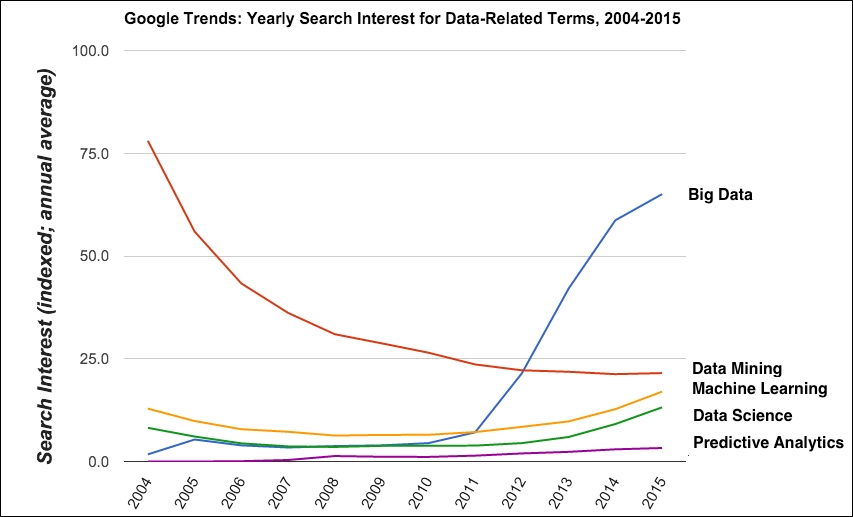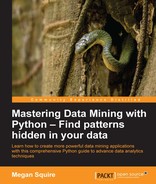When faced with sensory information, human beings naturally want to find patterns to explain, differentiate, categorize, and predict. This process of looking for patterns all around us is a fundamental human activity, and the human brain is quite good at it. With this skill, our ancient ancestors became better at hunting, gathering, cooking, and organizing. It is no wonder that pattern recognition and pattern prediction were some of the first tasks humans set out to computerize, and this desire continues in earnest today. Depending on the goals of a given project, finding patterns in data using computers nowadays involves database systems, artificial intelligence, statistics, information retrieval, computer vision, and any number of other various subfields of computer science, information systems, mathematics, or business, just to name a few. No matter what we call this activity – knowledge discovery in databases, data mining, data science – its primary mission is always to find interesting patterns.
Despite this humble-sounding mission, data mining has existed for long enough and has built up enough variation in how it is implemented that it has now become a large and complicated field to master. We can think of a cooking school, where every beginner chef is first taught how to boil water and how to use a knife before moving to more advanced skills, such as making puff pastry or deboning a raw chicken. In data mining, we also have common techniques that even the newest data miners will learn: How to build a classifier and how to find clusters in data. The title of this book, however, is Mastering Data Mining with Python, and so, as a mastering-level book, the aim is to teach you some of the techniques you may not have seen in earlier data mining projects.
In this first chapter, we will cover the following topics:
- What is data mining? We will situate data mining in the growing field of other similar concepts, and we will learn a bit about the history of how this discipline has grown and changed.
- How do we do data mining? Here, we compare several processes or methodologies commonly used in data mining projects.
- What are the techniques used in data mining? In this section, we will summarize each of the data analysis techniques that are typically included in a definition of data mining, and we will highlight the more exotic or underappreciated techniques that we will be covering in this mastering-level book.
- How do we set up a data mining work environment? Finally, we will walk through setting up a Python-based development environment that we will use to complete the projects in the rest of this book.
We explained earlier that the goal of data mining is to find patterns in data, but this oversimplification falls apart quickly under scrutiny. After all, could we not also say that finding patterns is the goal of classical statistics, or business analytics, or machine learning, or even the newer practices of data science or big data? What is the difference between data mining and all of these other fields, anyway? And while we are at it, why is it called data mining if what we are really doing is mining for patterns? Don't we already have the data?
It was apparent from the beginning that the term data mining is indeed fraught with many problems. The term was originally used as something of a pejorative by statisticians who cautioned against going on fishing expeditions, where a data analyst is casting about for patterns in data without forming proper hypotheses first. Nonetheless, the term rose to prominence in the 1990s, as the popular press caught wind of exciting research that was marrying the mature field of database management systems with the best algorithms from machine learning and artificial intelligence. The inclusion of the word mining inspires visions of a modern-day Gold Rush, in which the persistent and intrepid miner will discover (and perhaps profit from) previously hidden gems. The idea that data itself could be a rare and precious commodity was immediately appealing to the business and technology press, despite efforts by early pioneers to promote the holistic term knowledge discovery in databases (KDD).
The term data mining persisted, however, and ultimately some definitions of the field attempted to re-imagine the term data mining to refer to just one of the steps in a longer, more comprehensive knowledge discovery process. Today, data mining and KDD are considered very similar, closely related terms.
What about other related terms, such as machine learning, predictive analytics, big data, and data science? Are these the same as data mining or KDD? Let's draw some comparisons between each of these terms:
- Machine learning is a very specific subfield of computer science that focuses on developing algorithms that can learn from data in order to make predictions. Many data mining solutions will use techniques from machine learning, but not all data mining is trying to make predictions or learn from data. Sometimes we just want to find a pattern in the data. In fact, in this book we will be exploring a few data mining solutions that do use machine learning techniques, and many more that do not.
- Predictive analytics, sometimes just called analytics, is a general term for computational solutions that attempt to make predictions from data in a variety of domains. We can think of the terms business analytics, media analytics, and so on. Some, but not all, predictive analytics solutions will use machine learning techniques to perform their predictions. But again, in data mining, we are not always interested in prediction.
- Big data is a term that refers to the problems and solutions of dealing with very large sets of data, irrespective of whether we are searching for patterns in that data, or simply storing it. In terms of comparing big data to data mining, many data mining problems are made more interesting when the data sets are large, so solutions discovered for dealing with big data might come in handy to solve a data mining problem. Nonetheless, these two terms are merely complementary, not interchangeable.
- Data science is the closest of these terms to being interchangeable with the KDD process, of which data mining is one step. Because data science is an extremely popular buzzword at this time, its meaning will continue to evolve and change as the field continues to mature.
To show the relative search interest for these various terms over time, we can look at Google Trends. This tool shows how frequently people are searching for various keywords over time. In the following figure, the newcomer term data science is currently the hot buzzword, with data mining pulling into second place, followed by machine learning, data science, and predictive analytics. (I tried to include the search term knowledge discovery in databases as well, but the results were so close to zero that the line was invisible.) The y-axis shows the popularity of that particular search term as a 0-100 indexed value. In addition, I combined the weekly index values that Google Trends gives into a monthly average for each month in the period 2004-2015.

Google Trends search results for five common data-related terms
